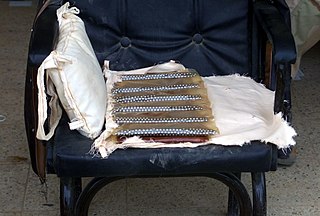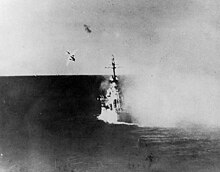
A bomb is an explosive weapon that uses the exothermic reaction of an explosive material to provide an extremely sudden and violent release of energy. Detonations inflict damage principally through ground- and atmosphere-transmitted mechanical stress, the impact and penetration of pressure-driven projectiles, pressure damage, and explosion-generated effects. Bombs have been utilized since the 11th century starting in East Asia.

A car bomb, bus bomb, van bomb, lorry bomb, or truck bomb, also known as a vehicle-borne improvised explosive device (VBIED), is an improvised explosive device designed to be detonated in an automobile or other vehicles.

A pipe bomb is an improvised explosive device (IED) that uses a tightly sealed section of pipe filled with an explosive material. The containment provided by the pipe means that simple low explosives can be used to produce a relatively large explosion due to the containment causing increased pressure. The fragmentation of the pipe itself creates potentially lethal shrapnel.

An improvised explosive device (IED) is a bomb constructed and deployed in ways other than in conventional military action. It may be constructed of conventional military explosives, such as an artillery shell, attached to a detonating mechanism. IEDs are commonly used as roadside bombs, or homemade bombs.

An explosive belt is an improvised explosive device, a belt or a vest packed with explosives and armed with a detonator, worn by suicide bombers. Explosive belts are usually packed with ball bearings, nails, screws, bolts, and other objects that serve as shrapnel to maximize the number of casualties in the explosion.

A suicide weapon is a weapon designed to be used in a suicide attack, typically based on explosives.
The explosion of animals is an uncommon event arising through natural causes or human activity. Among the best known examples are the post-mortem explosion of whales, either as a result of natural decomposition or deliberate attempts at carcass disposal. Other instances of exploding animals are defensive in nature or the result of human intervention.
The proxy bomb, also known as a human bomb, is a tactic that was used mainly by the Provisional Irish Republican Army (IRA) in Northern Ireland during the conflict known as "the Troubles". It involved forcing people to drive car bombs to British military targets after placing them or their families under some kind of threat The tactic was later adopted by the FARC in Colombia and by rebels in the Syrian Civil War.
The tactics of terrorism are diverse. As important as the actual attacks is the cultivation in the target population of the fear of such attacks, so that the threat of violence becomes as effective as actual violence. The different tactics that terrorist groups utilize can be very simple to extremely complex.
The al-Khilani mosque bombing occurred on 19 June 2007 when a truck bomb exploded in front of the Shia Al-Khilani Mosque in Baghdad, Iraq. At least 78 people were killed and another 218 injured in the blast. The explosion occurred just two days after a four-day curfew banning vehicle movement in the city was lifted after the al-Askari Mosque bombing (2007), and just hours after 10,000 US troops began the Arrowhead Ripper offensive to the north of Baghdad. Because the site was a Shia mosque, the bombing is presumed to have been the work of Sunnis. The Sinak area where the explosion took place was also the targeted by a suicide car bomber on 28 May 2007, which resulted in 21 deaths.
Animal-borne bomb attacks are the use of animals as delivery systems for explosives. The explosives are strapped to a pack animal such as a horse, mule or donkey. The pack animal may be set off in a crowd.
In 2007, 34 terrorist attacks and clashes, including suicide attacks, killings, and assassinations, resulted in 134 casualties and 245 injuries, according to the PIPS security report. The report states that Pakistan faced 20 suicide attacks during 2007, which killed at least 111, besides injuring another 234 people. The PIPS report shows visible increase in suicide attacks after the siege of Lal Masjid.
This is a list of terrorist attacks in Pakistan in the calendar year 2011.
These are the list of Terrorist attacks in Pakistan in 2010.
In 2008, Pakistan saw 40 terrorist attacks, which caused 154 fatalities and 256 injuries.
In 2009, Pakistan suffered 50 terrorist, insurgent and sectarian-related incidents that killed 180 people and injured 300.
A car bombing was carried out by the Basque separatist organisation ETA on 16 September 1991 in the town of Mutxamel near Alicante. The target was the Civil Guard barracks in the town. However the bomb initially failed to explode near its target. The police treated the car as an abandoned vehicle, not realising that it contained a bomb and while being towed away, the car bomb exploded, killing two police officers and the civilian towing the car away. The bombing was the deadliest of the 40 attacks which ETA carried out in the Province of Alicante between 1979 and 2004.

The December 2013 Mansoura bombing occurred on the morning of Tuesday, 24 December 2013 in the Nile Delta city of Mansoura in Egypt. The target was the city's security directorate building that was partially collapsed after the attack. At least 16 people were killed, mostly policemen, while more than a hundred were injured, according to the Ministry of Interior. No one immediately claimed responsibility for the bombing but Prime Minister Hazem Al Beblawi, on behalf of the interim government, was quick to blame the Muslim Brotherhood of being behind the attack, labeling it a "terrorist organization" for the first time since the ouster of Mohamed Morsi on 3 July earlier this year. Egyptian authorities also stated that the militants received logistical support from Hamas. Ansar Bait al-Maqdis, an Al-Qaeda-linked group in the Sinai Peninsula, released an online statement claiming responsibility for the blast but the government sounded determined that the Muslim Brotherhood was behind it and intensified its crackdown on the organization. The incident is now widely believed by many to be a turning point in the nation's history as the future of both the Islamists and Egypt's stability remain shadowed and unclear with several violent clashes and other bombings taking place across the country following its ban.








